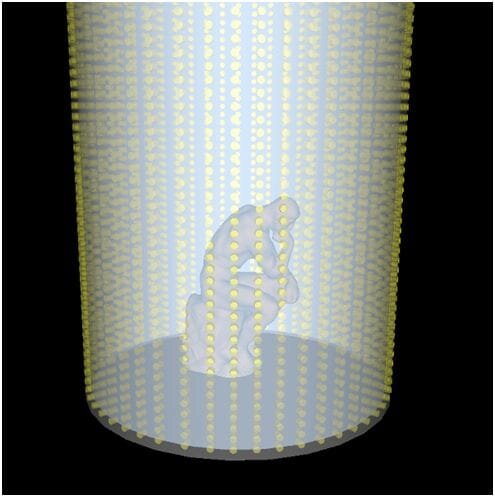 Electric 3D printing simulation — Image Source: RepRap Ltd
Electric 3D printing simulation — Image Source: RepRap Ltd
Charles Goulding and Steve Kelly of R&D Tax Savers report on the amazing research to develop a new electric 3D printing process.
Tea, Earl Grey, Hot.
This is the end-goal for many in 3D printing, and we may have just gotten closer to making this a reality with his electric 3D printing concept.
On October 12th, Adrian Bowyer presented his vision for the future of 3D printing to an audience at the East Coast RepRap Festival. As the founder of the RepRap project, he is a hero to many and helped kickstart the current 3D printing boom.
Penrose Self Replication
At the Festival we heard about the origins of the RepRap project, which was inspired by experiments such as Roger Penrose’s Automatic Self Replication experiments.
Towards the end of the talk, Bowyer spoke to the future of 3D printing and seemed particularly inspired by developments such as Lawrence Livermore National Lab’s one-piece 3D printing process.
Bowyer’s proposed printer involves no moving parts!
It is important to note that the idea is strictly theoretical, and has been published early as open-source in order to avoid patentability of the idea.
The process of printing is similar to a CT scan, but happens in reverse. 2D images are projected into the build chamber at all angles to gradually build up the object.
Electric 3D Printing
Arrays of electrodes around a cylindrical vat allow for the construction of potential wells throughout the build chamber. By directing this potential field throughout the chamber, a 3D component can be printed within seconds, without any moving parts.
Adrian has been working since July to develop the fundamental mathematics behind the printer and has published his work on GitHub for all to see. There is also a full build log on the RepRap Ltd website which can be found here.
For those who are interested, this may be an opportunity similar to the early days of the RepRap project. Adrian mentioned that materials, software, and hardware will all need to be explored to make this idea into a reality.
THE RESEARCH AND DEVELOPMENT TAX CREDIT
Enacted in 1981, the now permanent Federal Research and Development (R&D) Tax Credit allows a credit that typically ranges from 4%-7% of eligible spending for new and improved products and processes. Qualified research must meet the following four criteria:
-
Must be technological in nature
-
Must be a component of the taxpayer’s business
-
Must represent R&D in the experimental sense and generally includes all such costs related to the development or improvement of a product or process
-
Must eliminate uncertainty through a process of experimentation that considers one or more alternatives
Eligible costs include US employee wages, cost of supplies consumed in the R&D process, cost of pre-production testing, US contract research expenses, and certain costs associated with developing a patent.
On December 18, 2015, President Obama signed the PATH Act, making the R&D Tax Credit permanent. Beginning in 2016, the R&D credit can be used to offset Alternative Minimum tax for companies with revenue below US$50MM and, startup businesses can obtain up to US$250,000 per year in payroll tax cash rebates.
CONCLUSION
Adrian Bowyer’s new concept is yet to be proven, but if so it could certainly cause one of the biggest shakeups in 3D printing history.
Via RepRap Ltd

